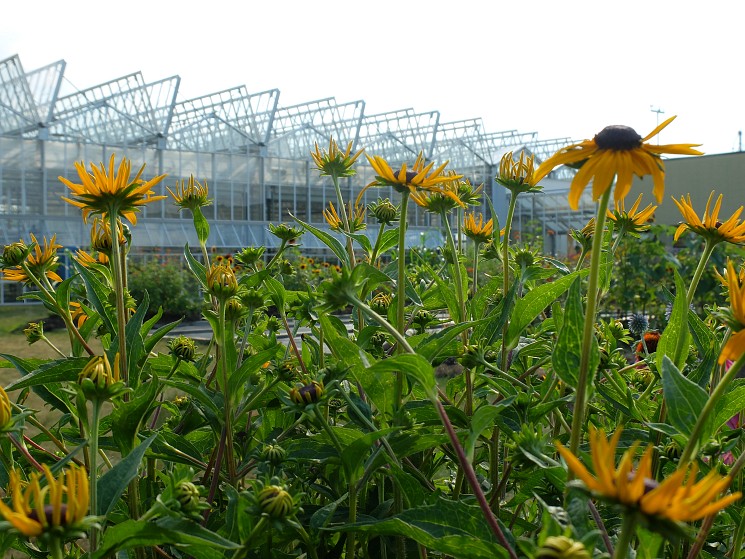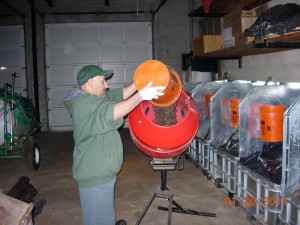Working Together to Create a More Sustainable Mount Auburn

Mount Auburn Cemetery is a cherished landscape. It is cherished for its beauty and tranquility, and for its historical significance. But if you look closer, Mount Auburn is much more than this. It is a vibrant institution, leading the way on sustainable horticultural practice and reinventing what a sacred place can be. Mount Auburn has gained a reputation as an urban oasis. Ripe for many forms of scientific and social interpretation, from citizen science inquiry, to a backdrop for many artists to delve into the questions of life, death, and remembrance.
Mount Auburn is always changing. Visitors may notice the seasonal cycles on the grounds, but the changes that are unseen are equally important. We are striving to become as significant for sustainability, as we are for our plant collections and monuments.
A grounds maintenance plan for the reduction and reuse of waste has been implemented. Increasing the amount of organic matter in the soil through compost and the mulching of grass and leaves, reduces the demand for fertilizer. The soil biology is improved and diversified, which allows for more effective nutrient cycling that in turn, benefits the plant collections. Soil can hold more water, reducing irrigation requirements and preventing erosion. Mulch is created on site by grinding woodchips with aged leaves. This reduces the cost of purchasing mulch, while eliminating its shipment to the cemetery. The mulch also increases organic matter in the soil. Implementing alternative fuel to replace a portion of the gas powered mower fleet has reduced harmful emissions. Choosing the right plant for the right place, along with incorporating lower volume sprinklers and pre-dawn irrigation schedules, conserves water at Mount Auburn.
At the greenhouse, rainwater is collected from the glass roofs into an underground cistern that is then used to irrigate the annual and perennial crops started inside. Beneficial insects and OMRI (Organic Materials Review Institute) listed materials are introduced through an integrated pest management (IPM) program, reducing the need for chemical treatments that are unhealthy for the earth and wildlife. Potting mix is created from compost, organic soiless mix, and coarse-grade sand, which dramatically reduces cost for material and shipment, along with irrigation and nutritional demands. Propagation materials are reused and recycled to save money and eliminate shipment to Mount Auburn as well.
The stone artisans implement sustainable care for the monument collection through the use of biological cleaners that do not require a final rinse, which reduces water consumption. Old, damaged stone is recycled for monument foundations and for restorative masonry.
Mount Auburn’s energy consumption is offset in part through the purchase of wind power credits. Solar power is currently under review by our preservation and facilities department to lessen the reliance on fossil fuel power and reduce our carbon footprint.
Recycled office materials are used throughout Mount Auburn. Cemetery and Visitor Services plan events that incorporate recycling and locally sourced food. Educational programs are created to inform and provide experiential learning across a diversity of disciplines.
All of these actions have led to a better Mount Auburn. Unfortunately, communication of all this work has not been as successful as the actions themselves. This is where a new sustainability effort can help inform and motivate our unique staff and volunteers.
Mount Auburn is implementing sustainability working groups to increase participation, communication, and ownership of sustainability at Mount Auburn. Three working groups of staff and volunteers will develop and implement goals and objectives for future sustainability actions, while providing support to achieve existing goals. The three working groups are: Education & Engagement, Energy & Greenhouse Gases, and Landscape & Habitat.
The Education & Engagement working group will work with staff and volunteers to improve communication on sustainability within Mount Auburn and with the public by developing educational opportunities as companion pieces to sustainable actions and by promoting the reduction of greenhouse gas emissions and the protection of soil, water, and air.
The Energy & Greenhouse Gases working group will work together to research and implement strategies that lessen reliance on fossil fuels and reduce Mount Auburn’s carbon footprint. It will support the preservation and facilities department and work with Education & Engagement to promote sustainability.
The Landscape & Habitat working group will provide assistance through research into sustainable horticulture practices and cost effective conservation strategies. It will work with Education & Engagement to promote wildlife habitat improvement actions and support the study of Mount Auburn as a ‘living laboratory’.
We truly are lucky to have such dedicated staff and volunteers at Mount Auburn. I hope that many will accept the call to action for sustainability, share their experiences, and incorporate sustainability into their jobs in a meaningful way.

Leave a Reply